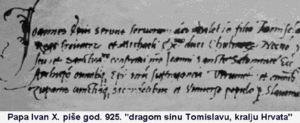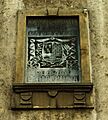Tomislav of Croatia facts for kids
Quick facts for kids Tomislav |
|
|---|---|

Equestrian statue of King Tomislav by Robert Frangeš-Mihanović, Zagreb, Croatia
|
|
| King of Croatia | |
| Reign | c. 925–928 |
| Successor | Trpimir II |
| Duke of Croatia | |
| Reign | c. 910–925 |
| Predecessor | Muncimir |
| Dynasty | Trpimirović |
| Father | Muncimir (suspected) |
| Religion | Christianity |
Tomislav was the very first king of Croatia. He started as the Duke of Croatia around 910 and became king in 925, ruling until about 928. During his time, Croatia teamed up with the Byzantine Empire to fight against the Bulgarian Empire. This led to a big war, ending with a major battle in 926. In the north, Croatia also had conflicts with the Principality of Hungary, but Tomislav managed to keep Croatia's borders safe and even expand a bit.
Tomislav also attended important church meetings in Split in 925. These meetings, called by Pope John X, discussed using Slavic languages in church services and who should control the church in Croatia. Even though the Pope wanted to stop Slavic languages in church, the council didn't agree. Because there isn't much information about Tomislav, we don't know the exact years he started and ended his rule. After him, Croatia faced some civil wars and became weaker.
Contents
King Tomislav of Croatia
Becoming a Leader
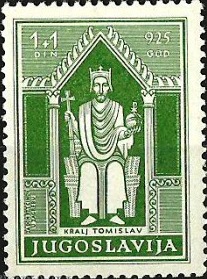
We don't know much about Tomislav's family, but he was likely part of the Trpimirović dynasty. He became Duke of Croatia around 910. This was about 20 years after the last mention of Muncimir, who was the duke before him. Many historians believe Tomislav was Muncimir's son.
After the Hungarians took over the Carpathian Basin in the late 800s and early 900s, they started raiding and expanding their land. They threatened a region called Lower Pannonia. The Hungarians also fought with Croatia. However, Croatia was not their main target.
An old book called the Chronicle of the Priest of Duklja says that Tomislav fought the Hungarians in a battle and won. Other records suggest both sides had wins and losses. Croatia managed to keep its northern borders. It even expanded into parts of the old Pannonian Duchy, including its capital, Sisak. The flat lands north of Sisak were hard to defend against Hungarian horsemen. But Sisak itself was well-protected.
To the east, the First Bulgarian Empire was growing very strong. After a war between the Bulgarian ruler Boris I and Croatian Duke Trpimir I, Croatia and Bulgaria had been friendly. But things changed in the 900s when Simeon I became the Bulgarian ruler. He wanted to control the Byzantine Empire.
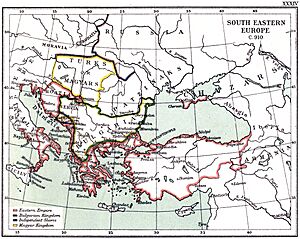
Tomislav's kingdom covered most of southern and central Croatia. It also included the coast of Dalmatia, except for areas controlled by the Byzantine Empire. It also included parts of what is now western Herzegovina and northern and western Bosnia. Croatia was divided into 11 counties at this time. Some areas were ruled by a special leader called a ban.
An old Byzantine emperor and writer, Constantine VII, wrote that Croatia could have a huge army. He said it could have 100,000 foot soldiers, 60,000 horsemen, and a fleet of 180 ships. However, most historians think these numbers are much too high. Experts believe the population of Croatia back then was between 440,000 and 880,000 people. Its army was probably closer to 20,000 to 100,000 foot soldiers and 3,000 to 24,000 horsemen.
Croatia's First King

Tomislav became the King of Croatia by 925. He was the first Croatian ruler to be called "king" by the Pope's office. We don't know exactly when, where, or by whom he was crowned. Letters from that time, found in a 13th-century book, call Tomislav "king." For example, a note before the 925 Council of Split calls him "King Tomislav in the province of the Croats." Pope John X also called him "King of the Croats."
Even though we don't have any stone carvings from Tomislav's time that say he was king, later rulers in the 900s did call themselves "kings." This helps confirm his title. Some older historians thought Tomislav was crowned in a field near a place called Duvno. But there are no real records to prove this. This idea came from another old book that described a different king's coronation.
Important Church Meetings
In 925, Pope John X held a church council in Split. The main goal was to decide which bishops would have power over the churches in the old Roman province of Dalmatia. Two bishops were fighting over this: Gregory, the Croatian bishop of Nin, and John, the archbishop of Split. Before the council, Bishop Gregory had a much larger area under his control. However, Split claimed it had been important since ancient times. Because of this, the council decided that Split would be the main church center. The area from the Raša River to Kotor, including Nin, would be under Split's control.
The council also talked about using the Croatian language and Glagolitic script in church services. The Pope wanted to stop it, but the council allowed local priests and monks to use it. However, these priests could not move up to higher positions in the church.
Tomislav, who was called a king in the documents, attended this council. Another ruler, Michael of Zahumlje, was also there. Some historians believe Michael recognized Tomislav's rule. Tomislav did not argue against the council's decisions. Bishop Gregory, however, appealed to the Pope. So, a second council was held in Split in 928 to settle the issue. This second council confirmed Split's power and closed down the Diocese of Nin.
Wars and Borders
During Tomislav's rule, the Bulgarian and Byzantine Empires were at war. The Bulgarians, led by Emperor Simeon I, defeated the Principality of Serbia in 924. Serbia was an ally of the Byzantine Empire. This forced the Serbian Prince and many Serbs to escape to Croatia. Croatia was also an ally of the Byzantine Empire. This meant Croatia was now between Bulgaria and the Byzantine lands. Tomislav might have gained some control over the coastal cities or a share of taxes from the Byzantine Empire for his help.
Since Croatia was helping Bulgaria's enemies and was allied with the Byzantine Empire, Simeon attacked. He sent an army into Croatia. Tomislav stopped the Bulgarian army and defeated them in a big battle in 926. This battle likely happened in eastern Bosnia. After Simeon died in 927, Pope John X sent people to help make peace between Croatia and Bulgaria.
We don't know how Tomislav died. He disappeared from history after 928. His successor was Trpimir II.
Geographic Extent
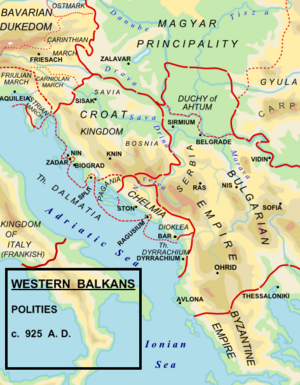
The exact size of Tomislav's kingdom is not fully known. An old writer named John the Deacon wrote that in 912, a Venetian ambassador traveled through Croatian territory. This suggests that Tomislav's Croatia bordered Bulgaria. Some historians believe it covered most of modern Croatia, Bosnia and Herzegovina, and the coast of Montenegro. Others think it didn't go as far south as Dubrovnik and didn't include Istria.
Many Croatian scholars say the kingdom covered the area south of the Drava River, extending to the Drina and Neretva rivers. However, some historians, like Nada Klaić, have questioned how far east (into Bosnia) Tomislav's kingdom really went.
Modern history books in Croatia often state that Tomislav's kingdom covered 60 to 80 percent of present-day Bosnia and Herzegovina. However, some historians, like John Van Antwerp Fine, are more cautious. Fine says that the sources from the 10th century are not always reliable. He believes that about a third of the eastern land shown on maps of Tomislav's kingdom is "entirely speculation." He suggests that parts of this territory might have been controlled by Bulgaria, early Serb groups, or local Slavic lords, rather than by a single Croatian state.
Tomislav's Legacy
Tomislav is remembered as the first Croatian king and the person who founded the first Croatian state. In Zagreb, the capital of Croatia, a square was named Tomislav Square in 1927. A statue of him was also put there by sculptor Robert Frangeš-Mihanović. In 1925, the Bosnian city of Duvno was renamed Tomislavgrad by King Alexander I of Yugoslavia. This was to celebrate 1,000 years since Tomislav's coronation. Many celebrations were held across the country. An obelisk (a tall, thin monument) was also built in his honor in Livno in 1926.
Tomislav's statue in Zagreb is shown on the 1000 kn banknote, which was issued in 1994. His name is also used for a dark beer brewed in Croatia.
Images for kids
See also
- History of Croatia
- Croatian–Bulgarian wars
- Grand Order of King Tomislav


